Imagine a world where lighting is not just a necessity but a dynamic tool that transforms spaces and moods. LED controllers, a comprehensive guide to modern lighting solutions, are at the forefront of this revolution. Yet, many remain unaware of their full potential, often perceiving them as complex or unnecessary.
Common misconceptions about LED controllers include the belief that they are difficult to install or require extensive technical knowledge. However, these devices are designed to be user-friendly, offering intuitive interfaces that allow anyone to customize their lighting environment effortlessly. The challenge lies in overcoming these misconceptions and embracing the possibilities they present.
The benefits of LED controllers are manifold. They offer unparalleled flexibility, energy efficiency, and the ability to create personalized lighting experiences. Whether for residential, commercial, or industrial applications, these controllers can significantly enhance the functionality and appeal of any space.
In this guide, we will explore the various types of LED controllers, their applications, and the latest innovations in the field. From smart home integration to energy-saving strategies, we will cover all the essential aspects you need to know.
Join us as we delve into the world of LED controllers, uncovering the secrets to harnessing their full potential. Let this guide be your beacon, illuminating the path to smarter, more sustainable lighting solutions.
Understanding LED Controllers
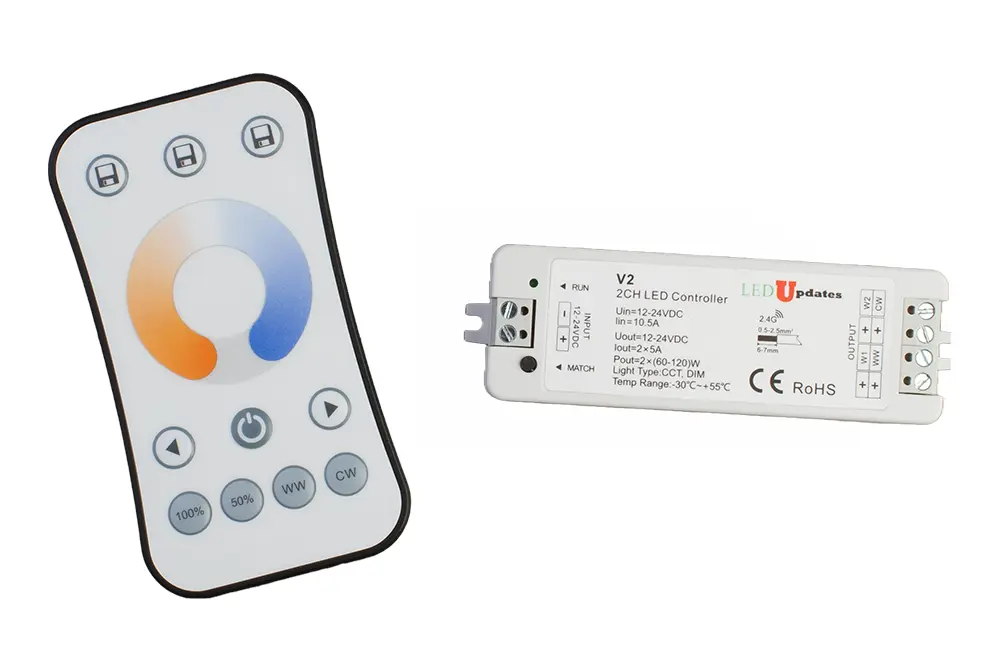
To embark on the journey of advanced lighting solutions, comprehending the fundamental concept of LED controllers is essential. These ingenious devices serve as the central nervous system for LED lighting installations, bridging the gap between simple light emissions and complex, fully-integrated scenarios.
Essentially, LED controllers are the masterminds behind each lighting sequence. They allow users to customize their lighting environment effortlessly.
From adjusting brightness levels to programming intricate patterns, controllers ensure LED systems deliver their full potential, mirroring the artistry of light in its finest form.
Smart technologies have revolutionized controllers, integrating features like wireless connectivity and voice control, to transform spaces with unprecedented precision.
This expanding universe of LED controllers offers unparalleled opportunities to personalize home and work environments, supporting enhancements in ambiance and energy efficiency alike. Through bold new interfaces and exceptional capabilities, they empower users to realize visions imagined only in dreams and convey a zest for embracing the future of illumination.
In essence, the LED controller is the powerhouse that brings visions alive through light, seamlessly fusing technology with creativity. Plus, understanding these controllers positions you to harness the endless possibilities awaiting in modern LED lighting systems.
Types of LED Controllers
LED controllers come in a diverse array, each tailored to specific applications, making them pivotal in modern lighting solutions. Among the most prevalent types are RGB controllers, dimmers, and DMX controllers, each offering unique benefits and functionality.
RGB controllers allow artists of light to paint vivid canvases using a palette of nearly endless colors. They enable the synchronization of multiple LEDs, achieving dynamic visual displays. In contrast, dimmer switches focus on luminosity, providing control over brightness to sculpt the ideal ambiance. Meanwhile, DMX controllers cater to theatrical and architectural settings, offering precise control over intricate lighting arrangements through hundreds of fixtures. Whether simple or complex, these controllers encapsulate the essence of creativity in LED lighting design.
Single-Color Controllers
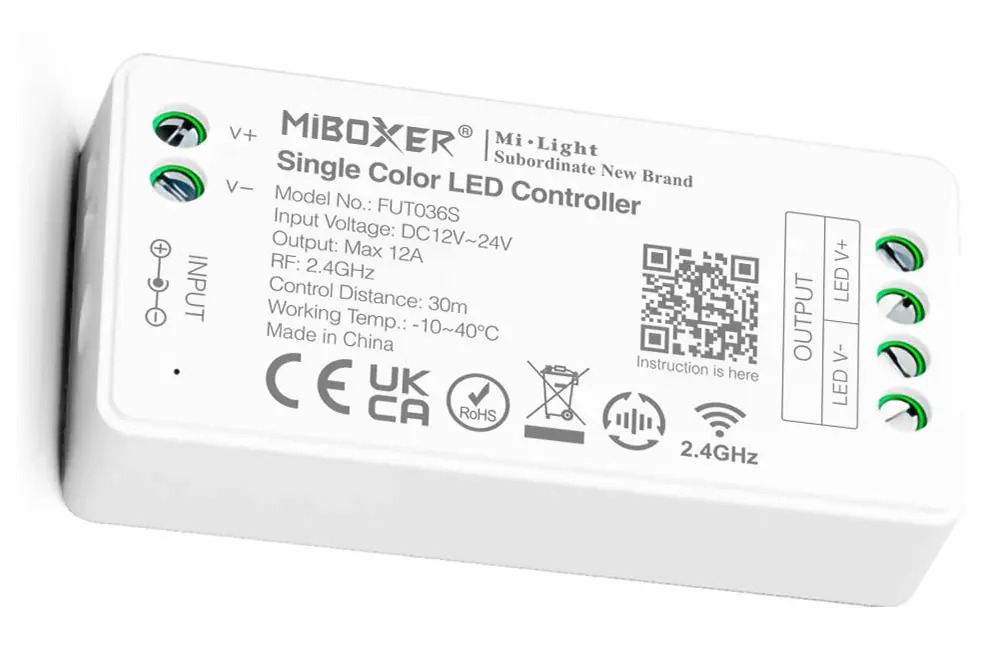
Single-color controllers simplify lighting management, delivering straightforward yet powerful solutions. These devices excel in applications where a specific, consistent color output is desired, ensuring uniformity and reliability.
When prioritizing luminosity and efficiency in a fixed hue, these controllers are the “go-to” solution. Ideal for locations that demand stability in lighting, they often find their application in industrial and residential environments.
Single-color LED controllers are celebrated for their ease of use and energy-saving capabilities.
Efficiency meets innovation: By tailoring the intensity of one color, single-color controllers cater to spaces requiring consistent illumination (think retail displays), enhancing the mood with a refined touch of precision. This ensures focused lighting atmospheres are accomplished effortlessly.
RGB LED Controllers
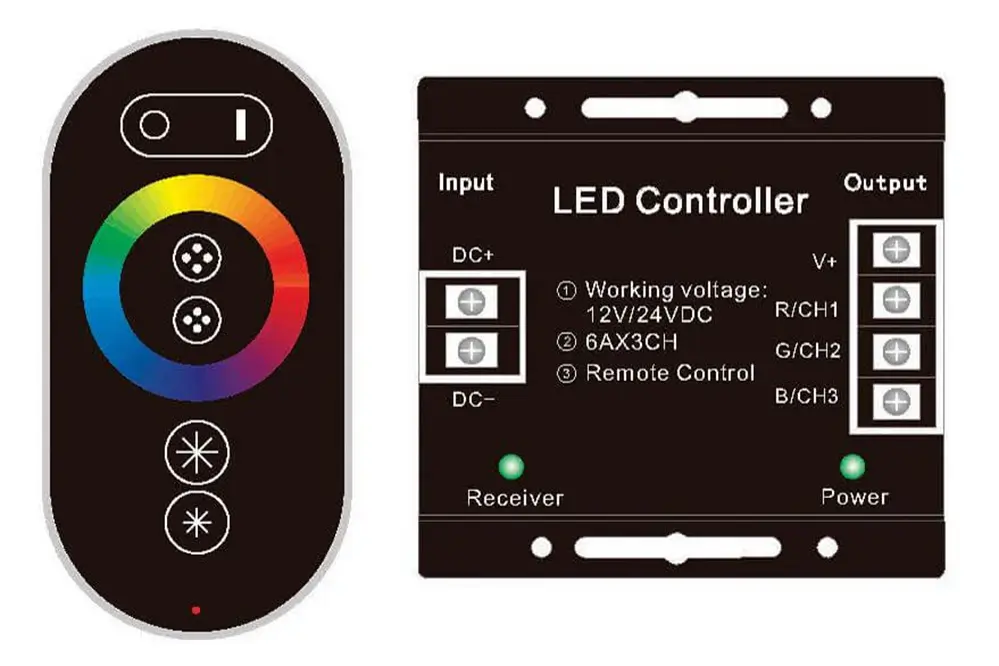
RGB LED controllers serve as the cornerstone of vibrant, dynamic lighting solutions, allowing users to seamlessly blend red, green, and blue hues.
- Versatile Color Mixing: Achieves a spectrum of colors by combining RGB values.
- Customizable Light Shows: Creates dynamic lighting effects and patterns.
- User-Friendly Interfaces: Intuitive apps or remote controls for ease of use.
- Energy Efficient: Optimizes energy consumption while delivering stunning visuals.
- Wide Application Range: Suitable for homes, theaters, or commercial displays.
These controllers unlock creativity, enabling customized ambiance tailored to individual preferences and environments.
Tapping into the transformative power of RGB technology, these controllers can redefine the lighting experience.
RGBW and RGBWW Controllers
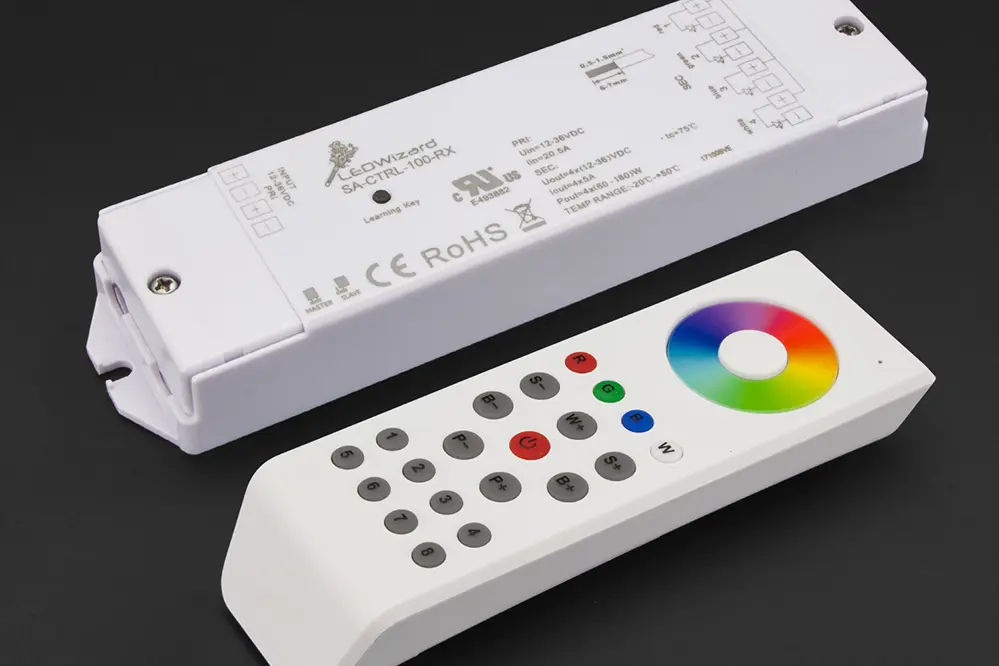
RGBW and RGBWW controllers introduce an extended palette, adding white and warm white to RGB, enhancing versatility and depth.
The inclusion of white in RGBW and warm white in RGBWW provides a remarkable advance in modern lighting, allowing more nuanced tones and precise lighting controls. White LED channels create sharper, more natural lighting experiences, which are advantageous for environments seeking enhanced visibility without color distortion.
Notably, these controllers enable a sophisticated manipulation of light quality. The added white LEDs enhance shadow definition and render truer color palettes that appeal to designers and consumers aiming for both function and aesthetics.
These advanced controllers are not only about added functionality but also about optimizing energy efficiency with sophisticated designs. They elevate lighting to new heights of precision and creativity, so whether for creating cozy residential settings, dazzling retail environments, or professional studio applications, they are truly transformative in redefining luminous potential.
How LED Controllers Work
LED controllers act as the brain, managing the operation of LED lights for optimal functionality and aesthetics.
At the core, an LED controller operates via a dynamic interplay between hardware and software, orchestrating the precise voltage and current flow to LEDs based on programmed commands. The adaptability and sophistication of these controllers mean users can customize lighting schemes to create vibrant atmospheres, facilitate mood settings, or enhance visual engagement in any environment.
Essentially, these devices serve as a sophisticated interface between user input and light output. With clever circuitry, LED controllers interpret data from input sources and adjust their output parameters, including brightness levels, color temperatures, and color mixtures, accordingly.
Through innovative technology, such as wireless or app-based control systems, LED controllers unlock unparalleled flexibility in lighting, offering intuitive interfaces for swift adjustments. This technological advancement has substantial implications, allowing seamless transitions between light settings, maximizing the interplay between form and function, and opening up endless possibilities for personal and professional illumination projects.
Benefits of Using LED Controllers
LED controllers offer increased efficiency, ensuring energy savings while elevating the overall aesthetic and functionality of lighting systems.
Firstly, by implementing LED controllers into a comprehensive lighting setup, users experience unparalleled flexibility, enabling them to effortlessly modify color spectrums, adjust dimming, and implement specific schedules to match their lighting preferences. These innovations not only slash energy consumption but also extend the lifespan of LED lights, safeguarding investments and promoting sustainability.
Moreover, these devices contribute to a sophisticated ambience in any setting. By supporting diverse lighting scenarios, they catalyze versatile applications, enhancing everything from cozy home interiors to dynamic commercial spaces and impressive event stages.
Lastly, the technological integration offered by LED controllers translates to optimized project outcomes and broadened creative freedoms. By adapting light arrangements and configurations with unprecedented ease, users are empowered to achieve their precise vision, harnessing the mesmerizing interplay between light and shadow. This inspires remarkable visual experiences and elevates any illumination project to its most stunning potential.
Selecting the Right LED Controller
Choosing the optimal LED controller is crucial to unlocking your lighting system’s full potential. Consider factors like compatibility, power handling, and user-friendliness to ensure your choice aligns with the needs of your project. Whether your focus is on precise color control, seamless integrations, or ease of use, an informed selection can propel your lighting endeavors to unimagined heights.
Next, evaluate if advanced features like wireless connectivity or app control are essential for your vision, offering flexibility and enhanced user experience.
Assessing Your Needs
Understanding your lighting project’s needs lays the foundation for selecting the perfect LED controller that complements your vision, achieving an ideal balance between aesthetic allure and functional brilliance.
Initially, contemplate the environment where your lighting elements will be deployed, considering ambient constraints.
Will your space benefit from static white lighting, or are you envisioning dynamic, color-rich transformations offering a spectrum of hues?
Such questions form the keystone for evaluating various performance characteristics of LED controllers, such as dimming precision and output intensity preferences.
Evaluating these factors enables a tailored approach to finding solutions that resonate with your specific illumination narrative, embracing the full potential of modern LED technology.
Ultimately, the goal revolves around transforming your space’s ambiance into something truly exceptional. Determine what evokes the desired mood and energizes interactions within your environment.
Compatibility Considerations
In the realm of LED controllers, ensuring compatibility is paramount. This involves astutely assessing the harmony between controllers, fixtures, and the broader electrical ecosystem.
A comprehensive understanding of the current electrical infrastructure will aid these considerations.
Compatibility, often neglected yet crucial, can make or break the project’s success (functionality hinges on compatibility).
A major factor lies in understanding communication protocols in use and ensuring seamless integration.
Selecting products from manufacturers who demonstrate robust backwards compatibility provides assurance for easier transitions and future upgrades compatible with both existing and new systems.
Ultimately, the goal is crafting a responsive environment that adapts effortlessly. Strategically choosing technology guarantees dependable perpetual lighting brilliance.
Installation Guide for LED Controllers
Embarking on the journey of installing an LED controller opens up a world of dynamic lighting possibilities with unparalleled precision and efficiency.
Initially, it is crucial to scrutinize the specifications of a chosen LED controller, ensuring that it aligns seamlessly with the existing lighting setup. Examining the wattage, voltage requirements, and compatibility with LED fixtures will provide an excellent foundation to deter any installation hiccups. Mapping out the circuit and verifying the location for power sources can mitigate common issues, laying the groundwork for a successful implementation.
Furthermore, secure installation relies on a structured approach to wiring connections. By adhering to the instruction manual, make precise connections to the power supply and LED fixtures. Continually check each connection’s robustness to avert potential disruptions or inefficiencies in the lighting system.
Finally, customizing and calibrating your LED controller can enhance lighting, matching both personal preferences and needs. With technological advancements, intelligent controls can automate scenes, optimizing ambiance and energy efficiency. Hence, spending time with the controller’s programming and utilizing user manuals will open avenues for innovative lighting applications, enhancing spatial aesthetics while inspiring a sustainable future.
Smart LED Controllers and Connectivity
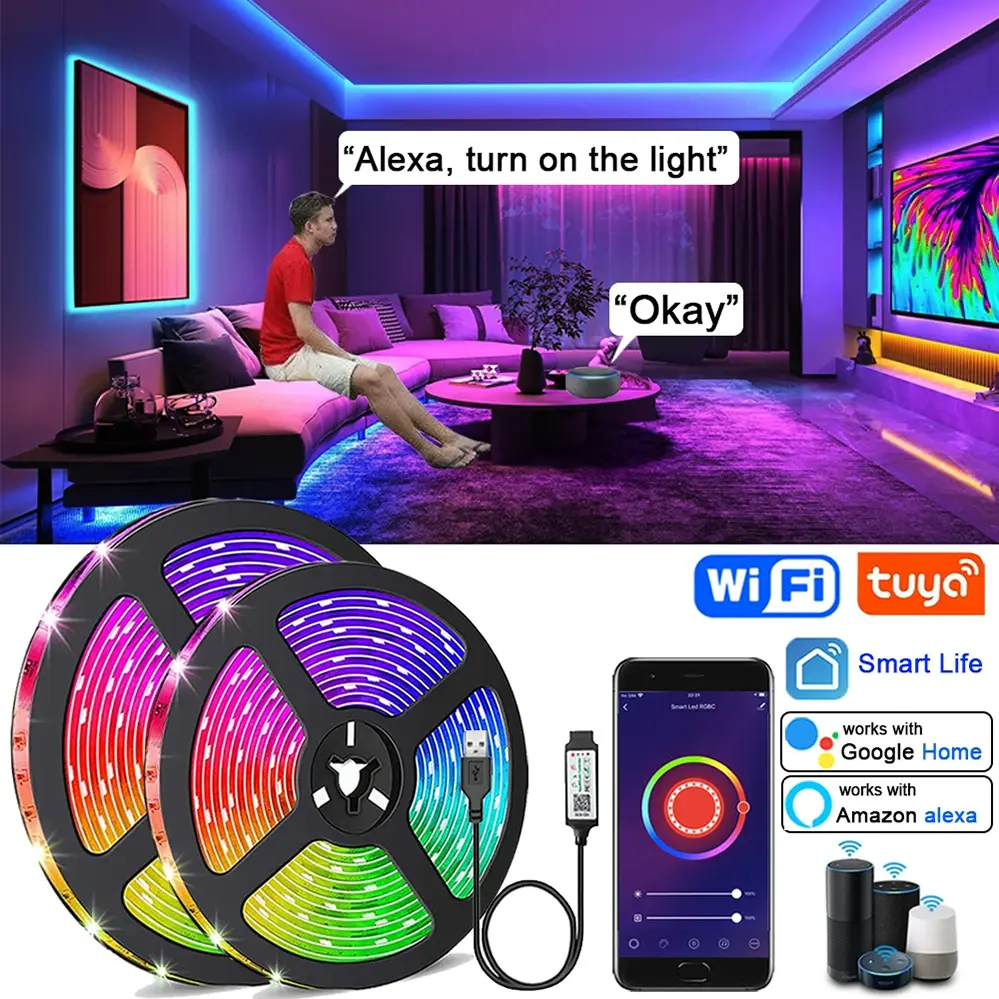
In today’s technologically advanced landscape, a plethora of sophisticated smart LED controllers are transforming lighting experiences. These controllers not only offer seamless integration with smart home ecosystems, effortlessly adjusting to dynamic lifestyles, but also open up a world where lighting is just a voice command away. By fostering connectivity among devices and apps, users can craft multifunctional lighting systems that collaboratively enhance the essence of any space, all while remaining at the forefront of energy-efficient innovations.
Wi-Fi and Bluetooth Options
Embracing the future of lighting, Wi-Fi and Bluetooth-enabled LED controllers offer unparalleled convenience and control.
- Wi-Fi Connectivity: Seamlessly integrate your lighting system with smart home devices, accessing global control right from your smartphone or voice assistant.
- Bluetooth Functionality: Enjoy localized control, optimizing convenience and efficiency without the need for complex network installations.
- User-Friendly Apps: Both platforms often include intuitive applications, providing easy customization of color, brightness, and schedules.
- Easy Installation: Generally, these controllers are straightforward to install, allowing you to start personalizing your lighting quickly.
- Enhanced Security: Choose options with secure connectivity features to protect your setup and ensure peace of mind.
Utilizing Wi-Fi and Bluetooth controllers unlocks sophisticated lighting personalization options.
With technological innovation at its core, these solutions invite users into a new era of smart, energy-efficient lighting.
Integration with Smart Home Systems
Integrating your LED controller with smart home systems, including dimmers, elevates the convenience and efficiency of modern lighting solutions.
- Compatibility with Major Platforms: Ensure your LED strip light controllers are compatible with leading smart home platforms like Amazon Alexa, Google Home, and Apple HomeKit.
- Voice Control Integration: Enjoy hands-free lighting management by connecting your LED system to voice-activated smart assistants.
- Automated Routines: Set up automated routines to synchronize your lighting with other smart home devices, creating seamless daily schedules.
- Remote Access: Control your lighting from anywhere in the world, ensuring your home is always prepared to welcome you with the perfect ambiance.
- Energy Monitoring: Utilize advanced monitoring features to track and optimize energy usage across your smart lighting system.
OPT enthusiasts find joy in streamlined smart home setups.
Pair your LED controllers with smart devices, paving the way for a dynamic, intuitive home.
Troubleshooting Common LED Controller Issues
Navigating LED controller hurdles can seem daunting at first.
Many users experience issues that arise from connectivity glitches. Often these challenges are due to network incompatibility or device settings, which can be easily rectified with patience and attention to detail. Additionally, turning off and then powering on your devices frequently helps recalibrate and align connection pathways.
When the controller doesn’t respond, resetting usually works.
Be it interference from other devices or an outdated firmware – the root cause might lie there. Ensure your LED controller and associated apps are updated to the latest versions for seamless operation.
Consider consulting manufacturer guidelines for advanced troubleshooting techniques, as they often provide detailed instructions tailored to specific models. Staying informed and proactive by leveraging the latest insights from 2023 will bolster your confidence and ensure your LED controllers deliver consistently stellar performance.
Innovative Uses for LED Controllers
Transform your space with dynamic lighting technology.
The integration of LED controllers opens new doors for creativity. These devices allow for the precise manipulation of light’s vibrant characteristics, such as color, intensity, and timing sequences, providing users with the aptitude to craft mesmerizing ambiances. This versatility extends the application scope of LED lighting beyond mere illumination into the realm of artistic expression.
Home decor enthusiasts find LED controllers exciting.
They cater to various styles and moods – be it the soft glow that evokes calmness or the vibrant hues exuding liveliness – thus helping transform environments with tailor-made lighting scenes.
Moreover, businesses are tapping into innovative solutions, optimizing their environments through strategically choreographed displays, particularly in retail and hospitality sectors. Such initiatives not only enhance visual appeal but also enrich customer experiences, aligning modern design sensibilities with cutting-edge 2023 technologies. These advancements are a testament to the pivotal role LED controllers play in redefining illumination as we know it, inviting all to harness their transformative potential.
Future Trends in LED Controller Technology
As innovation continues to accelerate rapid advancements across LED technology, the realm of controllers is poised for transformative developments, promising a future where lighting solutions become more intelligent, adaptable, and efficient.
Artificial intelligence emerges as the next frontier driving this evolution.
Imagine controllers capable of predicting user preferences, learning from prior usage, and autonomously adjusting settings based on mood or activity patterns.
Furthermore, enhanced connectivity tools will revolutionize integration with smart home ecosystems, creating environments that are responsive and intuitive.
Next-generation interfaces aim to streamline user experiences, making it seamless for individuals to navigate, customize, and control their lighting ambiance through voice, gestures, or mobile devices.
Undoubtedly, the horizon of LED controller technology is dazzlingly bright. Global collaboration among innovators propels us toward smarter, eco-friendly nonlinear lighting solutions.
Conclusion
LED controllers revolutionize lighting solutions.
As we reflect on the capabilities and potential of LED controllers, we recognize their pivotal role in modern lighting. These devices not only enhance aesthetic appeal but also significantly contribute to energy efficiency and smart connectivity. Their development is a testament to human ingenuity and innovation in technology.
A future brimming with possibilities awaits.
Their transformative utility spans from residential spaces to sophisticated commercial projects, solidifying their place as indispensable in lighting design.
Innovation in LED controller technology continues to redefine how we interact with our environments, pushing boundaries and expanding horizons. As we advance into an era that prioritizes sustainability and intelligence, LED controllers will unwaveringly remain at the forefront, illuminating paths ahead with unmatched vibrancy and efficacy.





